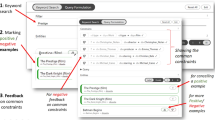Abstract
This study investigated difficulties in the comprehension of SPARQL. In particular, it compared the declarative and navigational styles present in the language, and various operators used in SPARQL property paths. The study involved participants selecting possible answers given a SPARQL query and knowledgebase. In general, no significant differences were found in terms of the response time and accuracy with which participants could answer questions expressed in either a declarative or navigational form. However, UNION did take significantly longer to comprehend than both braces and vertical line in property paths; with braces being faster than vertical line. Inversion and negated property paths both proved difficult, with their combination being very difficult indeed. Questions involving MINUS were answered more accurately than those involving negation in property paths, in particular where predicates were inverted. Both involve negation, but the semantics are different. With the MINUS questions, negation and inversion can be considered separately; with property paths, negation and inversion need to be considered together. Participants generally expressed a preference for data represented graphically, and this preference was significantly correlated with accuracy of comprehension. Implications for the design and use of query languages are discussed.
Access this chapter
Tax calculation will be finalised at checkout
Purchases are for personal use only
Similar content being viewed by others
Notes
- 1.
Although part of the language’s declarative style, MINUS was introduced in SPARQL1.1.
- 2.
- 3.
See https://github.com/w3c/sparql-12/issues/101. The likely reason for braces not being included in SPARQL1.1 property paths is the difficulty in deciding whether to opt for counting (bag) or non-counting (set) semantics. The former was the default in the original SPARQL standard. However, after the discovery of possible performance issues (see [12]), non-counting semantics were introduced in SPARQL1.1 specifically for property paths of unlimited length, i.e. using star (*) or plus (+); while leaving counting semantics as the default for all other SPARQL constructs.
- 4.
Provided by Empirisoft: http://www.empirisoft.com.
- 5.
The Wilcoxon test is a non-parametric test used in a within-participants study to compare two conditions. It can be considered as a non-parametric analogue of a paired t-test.
- 6.
The Wilcoxon test is a non-parametric test used in a within participants study to compare more than two conditions. It can be regarded as a non-parametric analogue of a repeated measures ANOVA.
- 7.
Spearman’s rank correlation is a non-parametric measure of the correlation between the ranks of two variables. In this and subsequent Spearman’s rank tests, the exact p-value could not be computed because of ties.
References
Prud’hommeaux, E., Seaborne, A.: SPARQL Query Language for RDF (2008) https://www.w3.org/TR/rdf-sparql-query/. Accessed 28 June 2019
Harris, S., Seaborne, A.: SPARQL 1.1 Query Language’ (2013). https://www.w3.org/TR/sparql11-query/. Accessed 28 June 2019
Gallego, M.A., Fernández, J.D., Martínez-Prieto, M.A., de la Fuente, P.: An empirical study of real-world SPARQL queries (2011). Accessed 02 Nov 2015
Rietveld, L., Hoekstra, R.: Man vs. machine: Differences in SPARQL queries (2014)
Bielefeldt, A., Gonsior, J., Krötzsch, M.: Practical Linked Data Access via SPARQL: The Case of Wikidata (2018)
Bonifati, A., Martens, W., Timm, T.: An analytical study of large SPARQL query logs. VLDB J. 29, 655–679 (2020). https://doi.org/10.1007/s00778-019-00558-9
Warren, P., Mulholland, P.: Using SPARQL – the practitioners’ viewpoint. In: Faron Zucker, C., Ghidini, C., Napoli, A., Toussaint, Y. (eds.) EKAW 2018. LNCS (LNAI), vol. 11313, pp. 485–500. Springer, Cham (2018). https://doi.org/10.1007/978-3-030-03667-6_31
Reisner, P.: Human factors studies of database query languages: a survey and assessment. ACM Comput. Surv. CSUR 13(1), 13–31 (1981)
Sarker, Md.K., Krisnadhi, A., Carral, D., Hitzler, P.: Rule-based OWL Modeling with ROWLTab protégé plugin. In: Blomqvist, E., Maynard, D., Gangemi, A., Hoekstra, R., Hitzler, P., Hartig, O. (eds.) ESWC 2017. LNCS, vol. 10249, pp. 419–433. Springer, Cham (2017). https://doi.org/10.1007/978-3-319-58068-5_26
Warren, P., Mulholland, P., Collins, T., Motta, E.: Improving comprehension of knowledge representation languages: a case study with description logics. Int. J. Hum.-Comput. Stud. 122, 145–167 (2019)
Seaborne, A.: SPARQL 1.1 Property Paths (2010). https://www.w3.org/TR/sparql11-property-paths/. Accessed 28 June 2019
Arenas, M., Conca, S., Pérez, J.: Counting beyond a Yottabyte, or how SPARQL 1.1 property paths will prevent adoption of the standard. In: Proceedings of the 21st International Conference on World Wide Web, pp. 629–638 (2012)
R Core Team R: A language and environment for statistical computing. R Foundation for Statistical Computing, Vienna, Austria (2013). ISBN 3-900051-07-0, 2014
Khemlani, S., Orenes, I., Johnson-Laird, P.N.: Negation: a theory of its meaning, representation, and use. J. Cogn. Psychol. 24(5), 541–559 (2012)
Orenes, I., Moxey, L., Scheepers, C., Santamaría, C.: Negation in context: evidence from the visual world paradigm. Q. J. Exp. Psychol. 69(6), 1082–1092 (2016)
Robinson, I., Webber, J., Eifrem, E.: Graph Databases. O’Reilly Media Inc., Sebastopol (2013)
Johnson-Laird, P.N.: The history of mental models. In: Manktelow, K., Chung, M. (eds.) Psychology of reasoning: Theoretical and Historical Perspectives. p. 179. Psychology Press (2004)
Ford, M.: Two modes of mental representation and problem solution in syllogistic reasoning. Cognition 54(1), 1–71 (1995)
Acknowledgements
The authors would like to thank all study participants; and also Enrico Daga for initial suggestions and assisting with participant contacts.
Author information
Authors and Affiliations
Corresponding author
Editor information
Editors and Affiliations
Rights and permissions
Copyright information
© 2020 Springer Nature Switzerland AG
About this paper
Cite this paper
Warren, P., Mulholland, P. (2020). A Comparison of the Cognitive Difficulties Posed by SPARQL Query Constructs. In: Keet, C.M., Dumontier, M. (eds) Knowledge Engineering and Knowledge Management. EKAW 2020. Lecture Notes in Computer Science(), vol 12387. Springer, Cham. https://doi.org/10.1007/978-3-030-61244-3_1
Download citation
DOI: https://doi.org/10.1007/978-3-030-61244-3_1
Published:
Publisher Name: Springer, Cham
Print ISBN: 978-3-030-61243-6
Online ISBN: 978-3-030-61244-3
eBook Packages: Computer ScienceComputer Science (R0)




